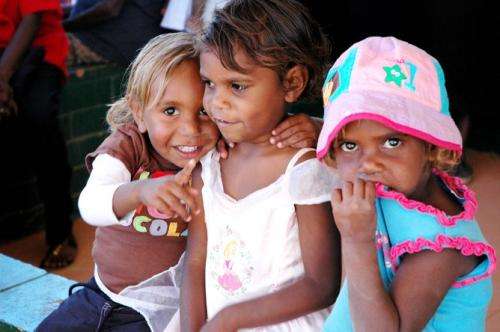Indigenous child health improves when fruit and veg are cheap, study finds

Providing subsidised fruit and vegetable scheme to low-income Indigenous families in northern New South Wales improves children's health and significantly reduces antibiotic use, a new study has found.
The new findings, published in the Medical Journal of Australia, showed that eating fruit and vegetables improved the children's levels of haemoglobin, reduced emergency department attendances and hospital visits for illness.
The researchers analysed data from health assessments, audits and blood testing of children aged 17 years and under from 55 families who attended three Aboriginal community-controlled health services and received a weekly box of subsidised fruits and vegetables.
The participants were assessed 12 months before the program and again 12 months later, between December 2008 and September 2010.
The results of this study showed that the children's haemoglobin levels significantly increased and the level of prescriptions of oral antibiotics markedly decreased compared to the year previous to the program. However iron deficiency and anaemia did not change significantly.
"There were definitely positive short-term health outcomes and, from our perspective, we observed children's health was better on this program, as they were sick less often and required less antibiotics," said the lead author of the study, Dr Andrew Black, from the University of South Australia's School of Population Health.
"I think the nutritional impacts of eating more fruit and vegetables have broader health impacts in the long term but that's definitely something we're interested in, the sustainability of this approach."
Dr Black said that for all the families involved in the study, the cost of fresh produce is a barrier to consumption of adequate daily fruit and vegetables.
"For a proportion of these families, who are struggling generally with issues in their lives, providing subsidised food isn't adequate by itself. There are a lot more challenges than making food cheaper for those families, but it's an important step and helps a significant number of people," he said.
Dr Black said that "families lined up to participate" in the program.
"They saw value in it and that enthusiasm is wonderful and it is potentially useful for health policy decision-makers to see the importance in this," he said.
Filling foods
Professor Amanda Lee, an indigenous nutrition expert from the Queensland University of Technology said the study showed that "it's clear we are losing the battle to improve nutrition in indigenous communities."
"We need more innovative solutions and fiscal interventions, particularly subsidisation of healthy foods, show a lot of promise."
Professor Lee said that objective measured data in remote communities showed that Aboriginal and Torres Strait Islander people may eat less than one serve a day of fruit or vegetables.
"People know what to do but they can't access the fruit and vegetables, they cant afford them or they are not available," said Professor Lee, who was not involved in the study.
"Fruit and vegetables are quite expensive in rural and regional communities, about 30% more. When people are hungry and they don't have enough food, you buy food that will fill you up and fruit and vegetables don't always do that. People are buying take-away, deep fried foods and bread to fill them up because they are hungry."
More information: www.mja.com.au/journal/2013/19 … -aboriginal-children
This story is published courtesy of The Conversation (under Creative Commons-Attribution/No derivatives).

















